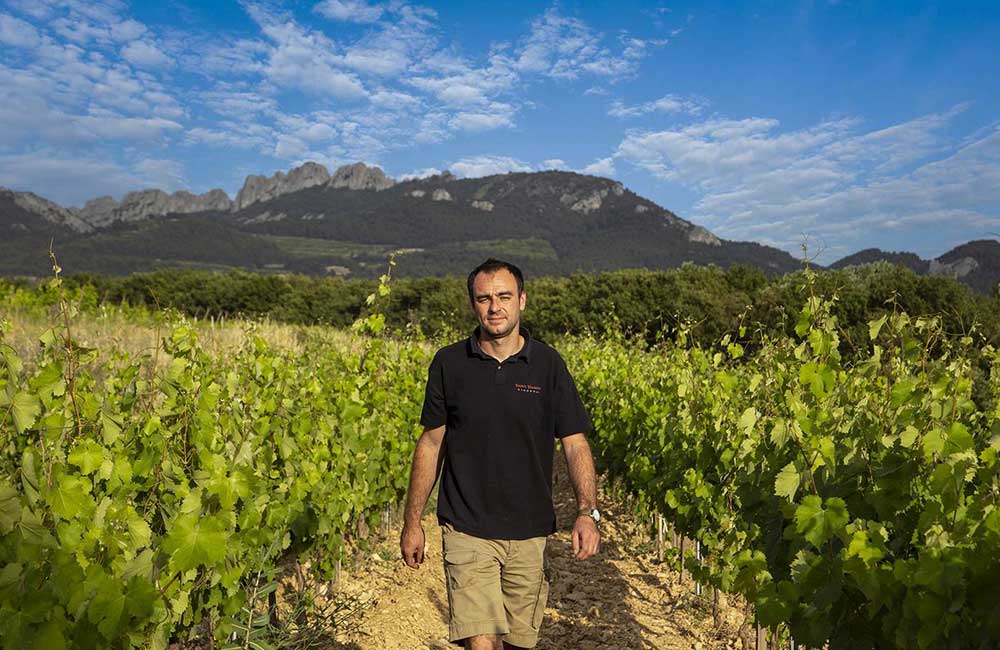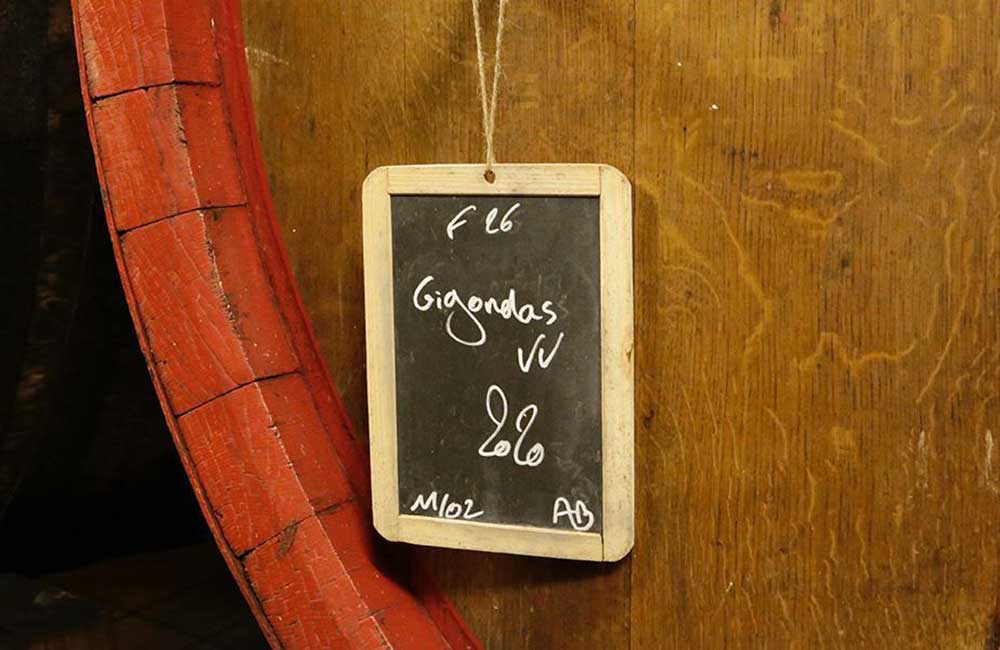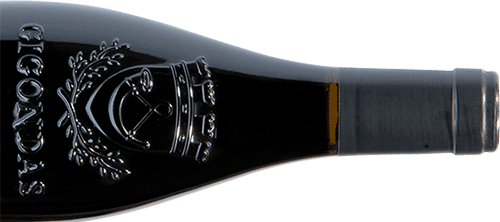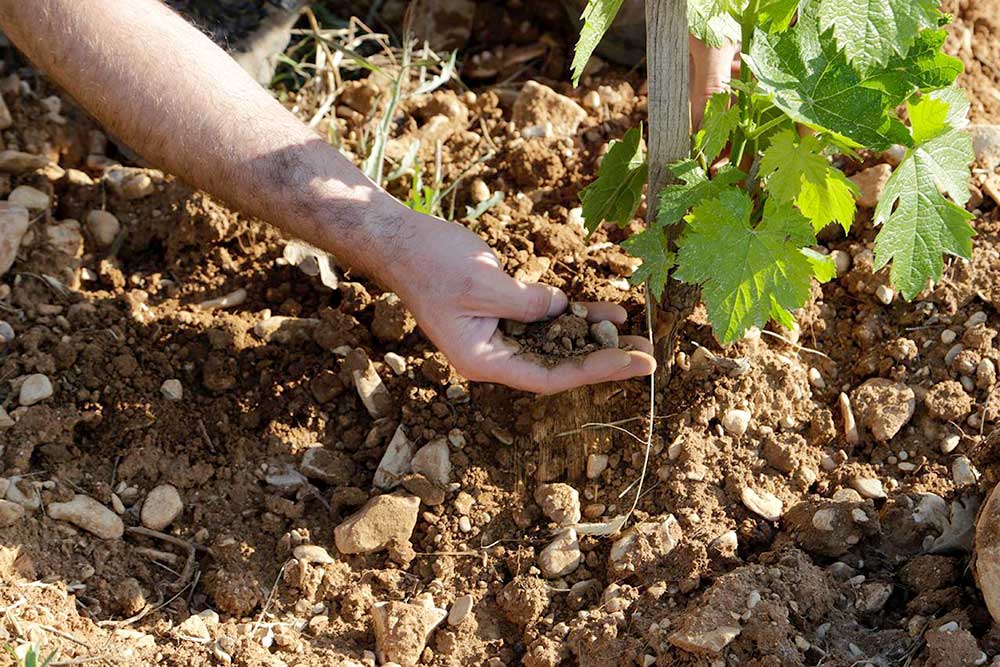The magnificent Rhône region of France follows the Rhône River from Vienne in the north, to Avignon in the south. Separated by about 60km, the region is divided into two sub-regions, the Northern Rhône and the Southern Rhône, both producing vastly different styles of wine. Jancis Robinson MW describes the wines of the Southern Rhône as “France’s most user-friendly,” being approachable, easy to enjoy and relatively affordable.
 Domaine Saint Damien's, Romain Saurel.
Domaine Saint Damien's, Romain Saurel.
The Southern Rhône is wider, flatter, warmer and much larger than the Northern Rhône. The climate in the south is Mediterranean (as opposed to maritime or continental) which means you find more moderate temperature variations between seasons. While the south enjoys more sunshine and less rain, it’s still frequently battered by the Mistral, a strong wind from the north west. The vegetation also changes dramatically, with olive trees, lavender, garrigue (scrubland) and rocky outcrops common in and around vineyards in the south.
The southern Rhône wines are classified as follows:
IGP (Indication Géographique Protegée)
This is the former entry level Vins de Pays category and is a little complicated in the Southern Rhône. You’ll find; Regional IGPs, several - some of which overlap, departmental IGPs and smaller, zonal IGPs. We generally don’t see too many of these wines in Australia.
.jpg) AOP (Appellation d’Origine Protegée)
AOP (Appellation d’Origine Protegée)
Prior to 2010 this was known as AOC (Appellation Contrôlée). This is where most of our drinking will be and a much easier system to grasp. There are 5 categories:
1. Côtes du Rhone AOP: one, catchall Côtes du Rhône appellation theoretically covers wine from anywhere within the region. In reality though, nearly all wine labelled Côtes du Rhône (CDR) comes from the vast and sunny Southern Rhône. This covers about 32,000 hectares and permits the use of 21 grape varieties, both red and white. However, the majority of wines are red (87%) and made from grenache, syrah and mourvèdre. Since 1996, red CDR must contain at least 40% grenache but (isn’t there always an exception?) wines made in the northern Rhône, where syrah is the favoured grape, are exempt from this rule.
2. Côtes du Rhône-Villages AOP: is a step up from standard CDR, with about 95 villages identified as superior and covers only about one tenth of the area of standard CDR. It allows 9 grape varieties and requires higher minimum alcohol levels and lower yields in the vineyards. The wines tend to be more full-bodied, and spicy in style than standard CDR.
3. Côtes du Rhone-Villages (with named village) AOP: is another step up in quality, with requirements regarding production more stringent still. The wines offer more depth and flavour and may also have been aged for a few years. There are currently 22 villages singled out for the superior quality of their wines, who are allowed to add their actual name to the label.
4. Individual ‘Cru’ (named commune or district): in the Southern Rhône there are 9 of these named communes or districts that have been granted their own appellations; Châteauneuf-du-Pape, Gigondas, Lirac, Tavel, Vacqueyras, Rasteau, Vinsobres, Cairanne and Beaumes-de-Venise.
5. ‘Satellite’ AOPs - these fall outside the main Southern Rhône area, the main ones being Luberon, Ventoux and Costières de Nîmes.
The best-known Cru of the Southern Rhône is of course Châteauneuf-du-Pape (CNDP), but worldwide demand for its gloriously rich and generous wines has pushed prices beyond the reach of most. It’s also focused attention on the more affordable wines of nearby Gigondas, an appellation traditionally in the shadow of CNDP, but more recently appreciated by astute drinkers for the value it offers.
Gigondas
As a respected colleague said to me “We need to bang the drum for Gigondas a lot louder - crazy good wines at half the price (or less) of CNDP.”
 The countryside around the tiny village of Gigondas has been noted for its wine since Roman times, but when official appellation rules were introduced in France in the 1930s, the area was rather surprisingly relegated to the generic Côtes du Rhône status. It took until 1966 for it to be elevated to ‘Côtes du Rhône-Villages’ and in 1971 it was finally recognised with its own appellation. The appellation sits within the Vaucluse département, a mere 10 miles northeast of CNDP, and with approximately 1,200ha of vines, is only about a third of the size. The often-terraced vineyards are protected by the imposing Dentelles de Montmirail, a saw-toothed limestone mountain range. Another feature of the landscape is the prevalence of garrigue, a low, soft and fragrant shrubbery found in limestone soils across parts of southern France.
The countryside around the tiny village of Gigondas has been noted for its wine since Roman times, but when official appellation rules were introduced in France in the 1930s, the area was rather surprisingly relegated to the generic Côtes du Rhône status. It took until 1966 for it to be elevated to ‘Côtes du Rhône-Villages’ and in 1971 it was finally recognised with its own appellation. The appellation sits within the Vaucluse département, a mere 10 miles northeast of CNDP, and with approximately 1,200ha of vines, is only about a third of the size. The often-terraced vineyards are protected by the imposing Dentelles de Montmirail, a saw-toothed limestone mountain range. Another feature of the landscape is the prevalence of garrigue, a low, soft and fragrant shrubbery found in limestone soils across parts of southern France.
With no white and about 1% rosé, it’s safe to think of Gigondas as a red wine appellation.
The official website for the Rhône Valley notes (with typical French bureaucratic simplicity) the makeup of Gigondas as:
- grenache may be used up to 80%.
- syrah and/or mourvèdre must account for a minimum of 15%.
- all other grape varieties covered by the Côtes du Rhône appellation are authorised, excluding carignan.
- and the following varieties may make up to 10% of the wine: cinsault, clairette and some stocks of terret noir, counoise and picardan.
So Gigondas is essentially a grenache dominant blend with a bit of syrah (shiraz) and mourvèdre, a blend we’re familiar with here in Australia.
 Traditional Gigondas is made in a similar way to CNDP, with long maceration. This means that when the wine is being made, it spends a long time in contact with the grape skins, giving it plenty of oomph and colour. Gigondas tends to be full, earthy, aromatic and relatively high in alcohol. The most commonly associated descriptors are powerful and rustic. You’ll find they have a lot in common with grenache from around the word, but likely have mineral notes and the telltale savoury herbal perfumed characteristics of garrigue, which “seems to encompass thyme, rosemary, sage, lavender, garlic and chives, often a signature component of southern French red wines.” Eric Asimov, NY Times wine critic.
Traditional Gigondas is made in a similar way to CNDP, with long maceration. This means that when the wine is being made, it spends a long time in contact with the grape skins, giving it plenty of oomph and colour. Gigondas tends to be full, earthy, aromatic and relatively high in alcohol. The most commonly associated descriptors are powerful and rustic. You’ll find they have a lot in common with grenache from around the word, but likely have mineral notes and the telltale savoury herbal perfumed characteristics of garrigue, which “seems to encompass thyme, rosemary, sage, lavender, garlic and chives, often a signature component of southern French red wines.” Eric Asimov, NY Times wine critic.
“(Gigondas)… are often thick-textured, with rugged tannins that give them their rustic reputation. But the best examples marry ripe, dark black fruit with fine-grained tannins and perfumed, minerally finishes. These wines age well, delivering mesquite, iron and black tea notes after five to eight years.” James Molesworth, Wine Spectator.
“A glass of Gigondas should provide a stimulating mix of plum or prune fruit, dark berries, spice, pepper and dried herbs. These are genuine, fresh, often well-priced wines, and finesse rather than raw strength quite rightly features in the appraisal of a Gigondas, be it young or mature.” John Livingstone-Learmonth, Decanter Magazine, Jan 2016.
Similar to the CNDP tradition, Gigondas producers also use a heavy bottle embossed with a distinctive insignia. This one features the hunting horn of the family of Orange (who ruled this area from the 12th century), and olive branches.
Domaine Saint Damien
I’ve offered wine from this Gigondas based estate in the past and am excited to offer you their latest releases from the 2020 vintage.
The seriously underrated Domaine St Damien has been run by the Saurel family since 1821, with the current custodians Joel and Amie Saurel at the helm since 1978. The couple changed the name to St Damien in 1979, naming it after a Chapel, long since fallen down, that stood near the estate, honouring St Damien, an early Christian saint who was martyred in 287AD. In case you were wondering, Damien is the patron saint of doctors, surgeons, blind people and barbers.
The estate traditionally sold its fruit to négociants, however Joel and Amie started to make their own wine in the mid-90s, soon after engaging renowned consultant Philippe Cambie, with admirable results. “Proprietor Joel Saurel, backed up by the inimitable Philippe Cambie as his consultant, has transformed this estate into one of the greatest locations in Gigondas, rivalling the two top producers…” Robert Parker, The Wine Advocate.
 "We only use natural products to protect the vine from different diseases: sulfur, copper in small quantities in the form of Bordeaux porridge, plant infusions, goat whey and essential oils." Domaine Saint Damien.
"We only use natural products to protect the vine from different diseases: sulfur, copper in small quantities in the form of Bordeaux porridge, plant infusions, goat whey and essential oils." Domaine Saint Damien.
Joel is largely responsible for the domaine’s current (insider) fame and was also the one who got the vineyards up to Agriculture Biologique certification in 2012, which means they’re certified organic.
These days the estate has a total of around 45 ha of vines, most of which are quite old and cropped low. Joel and Amie’s son Romain is in charge of winemaking and tends to age the wines in large, traditional concrete vats and old foudres, and then bottles them on the young side to preserve freshness. He also bottles without fining or filtration.
“Domaine Saint-Damien has been producing some of the region’s most elegant wines for years, but for some reason they rarely get the attention they deserve. Pricing here is also admirably fair, which makes this an address to be reckoned with for savvy Rhône wine lovers. These wines are now consistently delivering some of the southern Rhône’s greatest values in high-end wine.” Vinous Media, February 2020.
 Domaine Saint Damien Gigondas Vieilles Vignes 2020
Domaine Saint Damien Gigondas Vieilles Vignes 2020
This wine is a blend of 80% grenache and 20% mourvèdre. It was made using traditional methods, with fermentation carried out in lined concrete tanks, followed by extended maceration (5 weeks) and a further 12 months maturation in large oak (foudre). The idea behind this technique is that the concrete tanks allow retention of the natural fruit and mineral elements, while the large old oak allows the benefits of wood maturation without imparting an oaky character. The finished wine is 15% alcohol and sealed with cork.
“Looking at the Gigondas releases, the 2020 Gigondas Vieilles Vignes doesn’t give anything to the two single vineyard releases and offers awesome aromatics, full-bodied richness, a round, lush, yet pure mouthfeel, and ripe yet certainly present tannins. It’s loaded with Provençal, garrigue, and peppery goodness, and it’s going to be a brilliant value.”
95-97 points, Jeb Dunnuck, Jan 2022.
This is simply a great review, and a great price, for an entry level Gigondas. Indeed, it’s the only year I’ve seen the estate’s entry level Gigondas score better than the two more expensive single vineyards!
You’ll see it on the list at uber cool Porteño in Surry Hills for $140.
I can offer it for $55 a bottle (limited). SOLD OUT
 Domaine St Damien Côtes du Rhône Villages Plan de Dieu Vieilles Vignes 2020
Domaine St Damien Côtes du Rhône Villages Plan de Dieu Vieilles Vignes 2020
Aside from the estate’s Gigondas wines, St Damien also has vineyards a few kilometres away in Plan de Dieu, from which they source the fruit for this absolute bargain of a wine.
Plan de Dieu is one of eleven ‘named’ villages in the beautiful department of Vaucluse, about a 35 min drive north of historic Avignon, gateway to the Southern Rhône. The official ‘Vins Rhône’ website explains that the name originates from Plan Dei or Plain of God; “In the Middle Ages, crossing this vast bandit-infested forest of scrubland could mean taking your life into your own hands; all you could do was commit your soul to God.”
While the term Plan de Dieu goes back as far as 1326, the area didn’t gain named-village appellation status until 2005. These days the appellation covers over 900ha of fairly sparse landscape that yields barely a bottle per plant. The idea with yields is that less is often more in terms of the resulting quality. Plan de Dieu is a red-only appellation, with grenache, syrah and mourvèdre that produce “well-coloured, dense and concentrated wines, with aromas reminiscent of the surrounding Garrigue scrubland: thyme, bay and undergrowth.” Vins Rhône.
In true southern Rhône style, local winegrowers have designed their own snazzy bottle featuring the embossed words “Plan de Dieu” as well as a bunch of grapes topped with a halo.
This wine is a blend of 80% grenache and 20% mourvèdre, with the vines located on terraces in the village appellation of Plan de Dieu, which itself is within the commune of Violès. Vieilles Vignes means old vine, which is apt given the grenache vines date from 1948. The mourvèdre are from 2010. The grapes are co-fermented for 30 days in concrete vats before 8 months of aging (again in concrete). The wine is bottled without fining or filtration. The finished wine is 14.5% alcohol and is sealed with a cork.
In the glass this is a rich rosy red. On the nose you’ll find dark cherry with a hint of barnyard (in a good way). On the palate, dark cherry and raspberry jubey fruit meld with pepper, pith and graphite. Generous, medium to full-bodied with tannins firm but smooth. Lipsmacking and juicy.
“The old vine bottling of Plan de Dieu from Joel and Romain Saurel is composed of a blend of eighty percent grenache (vines planted in 1949) and twenty percent mourvèdre (vines planted in 1978). The grapes are co-fermented in cement vats and aged in the same for eight months prior to bottling. To my palate, this is a baby Gigondas and is a superb value!” John Gilman, View from the Cellar.
“Not yet bottled, the 2020 Côtes Du Rhône Villages Plan De Dieu Vieilles Vignes offers darker cherry and blackberry-like fruits as well as textbook Southern Rhône pepper, garrigue, and spice. It’s ripe, seamless, and undeniably delicious.” 89-92 points, JebDunnuck.com
This is a great review for a wine of this price. You’ll marvel at the depth and complexity this wine compared to standard CDRs. You’ll find it at oh-so-French Smith Street Bistro in Melbourne for $79 a bottle.
Stock up quickly - I only have a limited amount.
I can offer it for $30 a bottle (limited). SOLD OUT
 And… I also have two older vintages from the estate’s Gigondas La Louisiane single vineyard. These wines are 80% grenache (planted 1942), 15% mourvèdre (planted 1977), 5% syrah & cinsault (planted 1951). It was fermented on skins for 6 weeks before ageing in large old 50hl foudres for 12 months. Bottled unfined and unfiltered. Both wines are 15% alcohol and sealed with cork.
And… I also have two older vintages from the estate’s Gigondas La Louisiane single vineyard. These wines are 80% grenache (planted 1942), 15% mourvèdre (planted 1977), 5% syrah & cinsault (planted 1951). It was fermented on skins for 6 weeks before ageing in large old 50hl foudres for 12 months. Bottled unfined and unfiltered. Both wines are 15% alcohol and sealed with cork.
Domaine Saint Damien Gigondas La Louisiane 2018
“The 2018 Gigondas La Louisiane looks to be another terrific example of this cuvée. Raspberries, black cherries, tea leaves and violets all appear on the nose, while the full-bodied palate is rich, velvety and long on the finish.” 95-97 points, Robert Parker's Wine Advocate.
I can offer it for $65 a bottle. SOLD OUT
.gif) Domaine Saint Damien Gigondas La Louisiane 2019
Domaine Saint Damien Gigondas La Louisiane 2019
“I think the standout of the three Gigondas is the 2019 Gigondas La Louisiane. This ripe, exotic, yet incredibly pure Gigondas offers incredible character and depth with no sensation of weight or heaviness. Wild strawberries, blueberries, mint, peppery herbs, and garrigue are just some of the nuances, and it has silky tannins and a full-bodied, powerful style that will evolve for 10-15 years.” 97 points, Jeb Dunnuck, January 2022.
Rated #3 in Jeb Dunnuck’s top wines of 2022.
I can offer it for $67. SOLD OUT